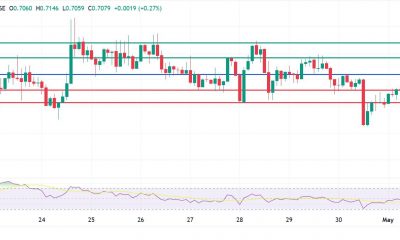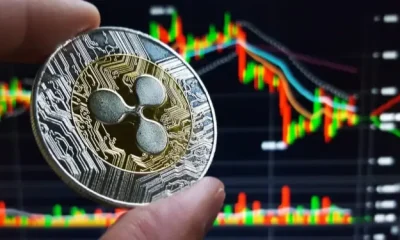

others
Mexican Peso falls on “super” Thursday – Crypto News
- The Mexican Peso edges lower prior to key inflation data and the Banxico May policy meeting.
- The Bank of Mexico is expected to keep rates unchanged but there is a risk of a revision to its forecasts.
- USD/MXN continues bumping along the bottom of a short-term range.
The Mexican Peso (MXN) is trading down about a quarter of a percent against US Dollar (USD) on Thursday ahead of key inflation data and the Bank of Mexico (Banxico) policy meeting, scheduled for later in the day.
The overall consensus from the analyst community is that Banxico will leave interest rates unchanged at 11.00% after cutting it in March. Lower interest rates are negative for a currency whilst higher rates are positive as they attract more foreign capital inflows.
USD/MXN is exchanging hands at 16.94, EUR/MXN at 18.20 and GBP/MXN at 21.15, at the time of publication.
Mexican Peso edges down on “super” Thursday
The Mexican Peso edges lower on Thursday ahead of key inflation data for April, scheduled at 12:00 GMT, and then the Banxico May monetary policy meeting a few hours later at 19:00 GMT.
Higher inflation forces central banks to keep interest rates high, which strengthens currencies as it attracts greater inflows of foreign capital. The opposite is true of lower inflation.
April’s Mexican headline Inflation is expected to rise to 4.63% year-over-year (YoY) but decline to 0.19% month-over-month (MoM), from 4.42% and 0.29%, respectively, the previous month.
The core inflation rate is forecast to decline to 4.40% YoY and 0.24% MoM.
If either deviates substantially from expectations, but especially core inflation – which is thought to be more accurate – the Mexican Peso could experience volatility.
Consensus is for Banxico to stick to policy status quo
At its previous March meeting, Banxico cut interest rates from 11.25% to 11.00% but said further rate cuts would be data dependent. In the time since, neither inflation nor growth have shown any further substantial declines – in fact growth in Q1 was slightly higher-than-expected.
In addition, Deputy Banxico Governor Jonathan Heath said in April that the central bank would probably hit pause on cutting interest rates in May due to strong Q1 growth.
Commerzbank does not expect Banxico to cut interest rates but sees a possibility it may revise up its exceedingly low inflation forecasts for the second half of 2024, which appear “optimistic” given the data so far. That said, its forecasts for Q1 were accurate.
“..the question of whether there will be a pronounced cycle of rate cuts is more likely to depend on whether inflation will continue to follow Banxico’s forecast in the coming quarters. This is because it expects the year-on-year rate to fall quite significantly in the coming quarters; for example, the core rate is expected to average only 3.5% year-on-year in the fourth quarter (compared to 4.57% in March),” says Commerzbank FX Analyst Michael Pfister.
Overall, a slowdown in economic growth is likely to be the main driver for Banxico eventually cutting interest rates, according to Commerzbank.
“To sum up, inflation argues against significant rate cuts, but slowing growth suggests that a slight correction in rates is likely – especially if Banxico revises downward its rather optimistic growth forecast of 2.8% for this year on Thursday,” says Pfister.
Banxico to hold – Wells Fargo
Wells Fargo also expects Banxico to leave interest rates unchanged.
It points out that inflation has not really shifted lower since the March meeting, and “..services inflation remains elevated, edging up to 5.37%. Meanwhile, stubborn U.S. inflation has seen the expected timing for Fed easing pushed back over the past several weeks.”
“Considering still-elevated domestic inflation, an initial Fed rate cut that is likely still several months away, and some sensitivity to the possibility of a weaker Mexican currency, we believe Banxico policymakers will opt to hold their policy rate steady at 11.00% next week,” Wells Fargo concludes.
Technical Analysis: USD/MXN on the floor of short-term range
USD/MXN – the cost of one US Dollar in Mexican Pesos – continues to bump along the bottom of a short-term range, with a floor at 16.86 and a ceiling at 17.40.
USD/MXN 4-hour Chart
The short-term trend is sideways, and given the old adage that the “trend is your friend”, it is expected to continue, suggesting the next move may be an oscillation higher.
The Moving Average Convergence Divergence (MACD) momentum indicator has crossed above its signal line, suggesting an increased chance of an up move evolving. The signal is enhanced by the fact that the MACD is more reliable in sideways trending markets.
A rise up within the range could take the USD/MXN to the 50 Simple Moving Average (SMA) on the 4-hour chart at 16.97, followed by the lower high at 17.15. A clear break above the zone of resistance around 17.15-17.18 might see further gains up towards the range highs again.
A decisive breakout of the range – either below the floor at 16.86, or the ceiling at 17.40 – would change the directional bias of the pair.
Given the overall bearish backdrop in the medium and long-term, odds favor a breakdown from the range.
A break below the range floor could see further downside to a target at 16.50, followed by the April 9 low at 16.26.
On the other side, a break above the top would activate an upside target first at 17.67, piercing a long-term trendline and then possibly reaching a further target at around 18.15.
A decisive break would be one characterized by a longer-than-average green or red daily candlestick that pierces above or below the range high or low, and that closes near its high or low for the period; or three green/red candlesticks in a row that pierce above/below the respective levels.
Mexican Peso FAQs
The Mexican Peso (MXN) is the most traded currency among its Latin American peers. Its value is broadly determined by the performance of the Mexican economy, the country’s central bank’s policy, the amount of foreign investment in the country and even the levels of remittances sent by Mexicans who live abroad, particularly in the United States. Geopolitical trends can also move MXN: for example, the process of nearshoring – or the decision by some firms to relocate manufacturing capacity and supply chains closer to their home countries – is also seen as a catalyst for the Mexican currency as the country is considered a key manufacturing hub in the American continent. Another catalyst for MXN is Oil prices as Mexico is a key exporter of the commodity.
The main objective of Mexico’s central bank, also known as Banxico, is to maintain inflation at low and stable levels (at or close to its target of 3%, the midpoint in a tolerance band of between 2% and 4%). To this end, the bank sets an appropriate level of interest rates. When inflation is too high, Banxico will attempt to tame it by raising interest rates, making it more expensive for households and businesses to borrow money, thus cooling demand and the overall economy. Higher interest rates are generally positive for the Mexican Peso (MXN) as they lead to higher yields, making the country a more attractive place for investors. On the contrary, lower interest rates tend to weaken MXN.
Macroeconomic data releases are key to assess the state of the economy and can have an impact on the Mexican Peso (MXN) valuation. A strong Mexican economy, based on high economic growth, low unemployment and high confidence is good for MXN. Not only does it attract more foreign investment but it may encourage the Bank of Mexico (Banxico) to increase interest rates, particularly if this strength comes together with elevated inflation. However, if economic data is weak, MXN is likely to depreciate.
As an emerging-market currency, the Mexican Peso (MXN) tends to strive during risk-on periods, or when investors perceive that broader market risks are low and thus are eager to engage with investments that carry a higher risk. Conversely, MXN tends to weaken at times of market turbulence or economic uncertainty as investors tend to sell higher-risk assets and flee to the more-stable safe havens.
-

 Technology1 week ago
Technology1 week agoOpenAI explains ‘THIS’ is why it reversed GPT-4o update amid sycophantic behavior concerns – Crypto News
-

 Cryptocurrency1 week ago
Cryptocurrency1 week agoCardano Price Finds $0.700 Support to Strengthen Upward Traction – Crypto News
-

 Metaverse1 week ago
Metaverse1 week agoAI Tool of the Week | How to run a strategy pre-mortem with ChatGPT’s o3 model – Crypto News
-

 Blockchain1 week ago
Blockchain1 week agoPeter Brandt Predicts When Bitcoin Price Might Reach $150,000, Technical Signals Show Where Market Is At – Crypto News
-

 others1 week ago
others1 week agoUS State Paying $2,000,000,000 To Residents – No Strings Attached – in First-Ever ‘Inflation Rebate’ Program – Crypto News
-

 Cryptocurrency1 week ago
Cryptocurrency1 week agoXRP jumps 30% on Ripple news – Crypto News
-
Technology1 week ago
US Senators Withdraw Support For GENIUS Act: Here’s Why – Crypto News
-

 Blockchain4 days ago
Blockchain4 days agoBitcoin Surpasses $100K Mark Amid New Trade Deal – Crypto News
-

 others1 week ago
others1 week agoDow Jones soars 600 points as NFP data calms recession fears, weekly gains top 3% – Crypto News
-

 Cryptocurrency1 week ago
Cryptocurrency1 week agoFriday Charts: Will natural intelligence keep us employed? – Crypto News
-
Technology1 week ago
TRUMP Token as Reserve Asset? US Logistics Firm Freight Technologies To Hold TRUMP – Crypto News
-

 Cryptocurrency1 week ago
Cryptocurrency1 week agoAnalysts Remain Bullish on Strategy’s Bitcoin Buying Plans – Crypto News
-

 Cryptocurrency1 week ago
Cryptocurrency1 week agoStatus (SNT) price up after 35% dev activity rise – Crypto News
-

 others1 week ago
others1 week agoBullish momentum, buyers don’t give up – Crypto News
-
others1 week ago
Singapore Retail Sales (YoY) climbed from previous -3.6% to 1.1% in March – Crypto News
-

 Cryptocurrency1 week ago
Cryptocurrency1 week agoWill Bitcoin Fall Below $90K as Ethereum and XRP Lose Momentum? – Crypto News
-

 Business7 days ago
Business7 days agoRite Aid Files for Bankruptcy, Job Cuts Expected – Crypto News
-

 Cryptocurrency1 week ago
Cryptocurrency1 week agoUS Treasury Predicts Stablecoin Market Could Surge to $2 Trillion by 2028 – Crypto News
-
Technology1 week ago
Bitcoin Price Eyes $100k as Saylor Buys $1.42B BTC — Fed Decision Looms – Crypto News
-
Technology1 week ago
Warren Buffett To Step Down, Will Berkshire Hathaway Finally Embrace Bitcoin? – Crypto News
-

 Metaverse1 week ago
Metaverse1 week agoChatGPT overtakes Elon Musk’s X in monthly traffic after viral Ghibli-style image trend – Crypto News
-
others1 week ago
Breaking: VanEck Files S1 Form With US SEC To Launch BNB ETF – Crypto News
-
others1 week ago
Breaking: VanEck Files S1 Form With US SEC To Launch BNB ETF – Crypto News
-
Technology1 week ago
ECB Kicks Off Digital Euro Testing with 70 Firms Across Europe – Crypto News
-

 Cryptocurrency5 days ago
Cryptocurrency5 days agoBNBInfinity surpasses 420+ BNB in global deposits as DeFi investors rally around high-yield, transparent smart contract – Crypto News
-

 Cryptocurrency5 days ago
Cryptocurrency5 days agoBNBInfinity surpasses 420+ BNB in global deposits as DeFi investors rally around high-yield, transparent smart contract – Crypto News
-

 Blockchain3 days ago
Blockchain3 days agoBitcoin yet to hit $150K because outsiders are ghosting — Michael Saylor – Crypto News
-

 others1 week ago
others1 week agoEuro steadies near 1.5600 as bulls hold longer-term edge – Crypto News
-
Business1 week ago
3 Altcoins to Buy If Donald Trump’s Trade Negotiations with China Fail – Crypto News
-

 Cryptocurrency1 week ago
Cryptocurrency1 week agoTether plans new US dollar stablecoin as reserves near $120B amid Washington lobbying – Crypto News
-
Business1 week ago
ETH Traders Hold $20.8 Billion Positions as Vitalik Buterin Plan to Fix Ethereum in 5 Years – Crypto News
-

 Metaverse1 week ago
Metaverse1 week agoWarren Buffett announces retirement from Berkshire Hathaway — these are his smartest bets, as per Perplexity AI – Crypto News
-

 Cryptocurrency1 week ago
Cryptocurrency1 week agoProject Open makes its case to the SEC – Crypto News
-

 others1 week ago
others1 week agoUSD/JPY retreats from highs as Dollar weakens and Japan signals tariff pushback – Crypto News
-
others1 week ago
Ripple Whale Moves $64M As Analyst Predicts XRP Price Bullish Breakout – Crypto News
-

 Cryptocurrency1 week ago
Cryptocurrency1 week agoWhat Does it Mean for Ripple’s Price? – Crypto News
-

 Cryptocurrency1 week ago
Cryptocurrency1 week agoNext Telegram Gaming Boom Will Come From Reinventing Classics: ‘Notcoin’ Founders – Crypto News
-
Technology1 week ago
Ethereum Price Recovery Soon? Key Factors Point To ETH Bull Rally Ahead – Crypto News
-

 Blockchain1 week ago
Blockchain1 week agoBitcoin At $100K? $3 Billion In Shorts Are On The Line – Crypto News
-

 Cryptocurrency1 week ago
Cryptocurrency1 week agoEthereum Price Prediction 2025, 2027, and 2030: Will ETH Reach $10,000 – Crypto News
-
Business1 week ago
Here is Dogecoin Price If DOGE ETF Gets 30% to 50% of Bitcoin ETF Inflows – Crypto News
-

 others1 week ago
others1 week agoAUD/JPY trades soft near 93.50 as global trade uncertainties increase safe-haven demand – Crypto News
-

 Metaverse1 week ago
Metaverse1 week agoMilken Conference: Elon Musk asks US govt to use AI to replace functions of some workers – Crypto News
-

 Technology7 days ago
Technology7 days agoOpenAI dials back conversion plan, nonprofit to retain control – Crypto News
-

 others7 days ago
others7 days agoRetail Traders Embracing ‘Gamble’ Mindset As Memecoin Discussions Hit Highest Level This Year, Warns Santiment – Crypto News
-

 Blockchain7 days ago
Blockchain7 days agoIs Another Drop on the Horizon? – Crypto News
-

 Blockchain6 days ago
Blockchain6 days agoA Correction To This Level Could Come First – Crypto News
-

 Blockchain6 days ago
Blockchain6 days ago$25 Million Pledge From Ripple Set To Benefit Teachers And Students Across The US – Crypto News
-

 others6 days ago
others6 days agoEuro steadies near 1.1300 with bullish bias intact – Crypto News
-

 Metaverse6 days ago
Metaverse6 days agoElon Musk to keep lawsuit against OpenAI: Why Sam Altman’s non-profit control U-turn fails to cheer Tesla chief – Crypto News












